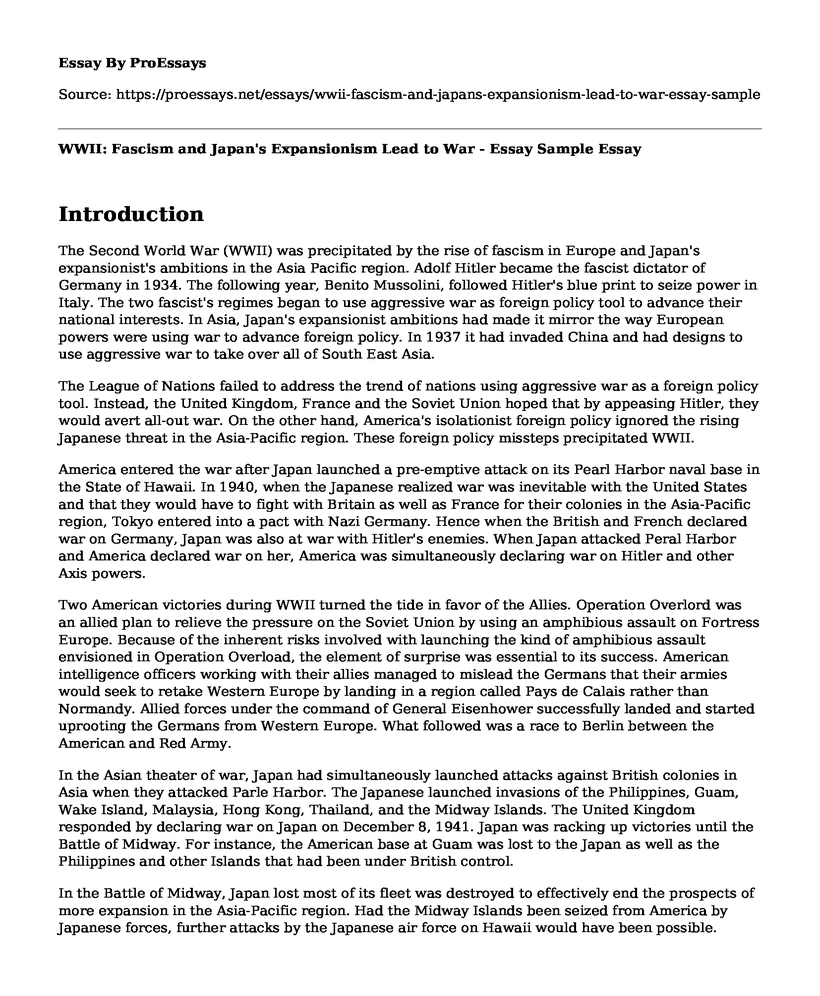Introduction
The Second World War (WWII) was precipitated by the rise of fascism in Europe and Japan's expansionist's ambitions in the Asia Pacific region. Adolf Hitler became the fascist dictator of Germany in 1934. The following year, Benito Mussolini, followed Hitler's blue print to seize power in Italy. The two fascist's regimes began to use aggressive war as foreign policy tool to advance their national interests. In Asia, Japan's expansionist ambitions had made it mirror the way European powers were using war to advance foreign policy. In 1937 it had invaded China and had designs to use aggressive war to take over all of South East Asia.
The League of Nations failed to address the trend of nations using aggressive war as a foreign policy tool. Instead, the United Kingdom, France and the Soviet Union hoped that by appeasing Hitler, they would avert all-out war. On the other hand, America's isolationist foreign policy ignored the rising Japanese threat in the Asia-Pacific region. These foreign policy missteps precipitated WWII.
America entered the war after Japan launched a pre-emptive attack on its Pearl Harbor naval base in the State of Hawaii. In 1940, when the Japanese realized war was inevitable with the United States and that they would have to fight with Britain as well as France for their colonies in the Asia-Pacific region, Tokyo entered into a pact with Nazi Germany. Hence when the British and French declared war on Germany, Japan was also at war with Hitler's enemies. When Japan attacked Peral Harbor and America declared war on her, America was simultaneously declaring war on Hitler and other Axis powers.
Two American victories during WWII turned the tide in favor of the Allies. Operation Overlord was an allied plan to relieve the pressure on the Soviet Union by using an amphibious assault on Fortress Europe. Because of the inherent risks involved with launching the kind of amphibious assault envisioned in Operation Overload, the element of surprise was essential to its success. American intelligence officers working with their allies managed to mislead the Germans that their armies would seek to retake Western Europe by landing in a region called Pays de Calais rather than Normandy. Allied forces under the command of General Eisenhower successfully landed and started uprooting the Germans from Western Europe. What followed was a race to Berlin between the American and Red Army.
In the Asian theater of war, Japan had simultaneously launched attacks against British colonies in Asia when they attacked Parle Harbor. The Japanese launched invasions of the Philippines, Guam, Wake Island, Malaysia, Hong Kong, Thailand, and the Midway Islands. The United Kingdom responded by declaring war on Japan on December 8, 1941. Japan was racking up victories until the Battle of Midway. For instance, the American base at Guam was lost to the Japan as well as the Philippines and other Islands that had been under British control.
In the Battle of Midway, Japan lost most of its fleet was destroyed to effectively end the prospects of more expansion in the Asia-Pacific region. Had the Midway Islands been seized from America by Japanese forces, further attacks by the Japanese air force on Hawaii would have been possible. Likewise, Australia would have fallen and Japan would be free to continue its planned military conquest of the Asia-Pacific region.
Cite this page
WWII: Fascism and Japan's Expansionism Lead to War - Essay Sample. (2023, May 04). Retrieved from https://proessays.net/essays/wwii-fascism-and-japans-expansionism-lead-to-war-essay-sample
If you are the original author of this essay and no longer wish to have it published on the ProEssays website, please click below to request its removal:
- Poster We Can Do It Analysis Essay Example
- Compare and Contrast Essay on Chinese and American Marriages
- The Depiction of Roman Culture in the Gladiator (2000) Film Essay
- Essay Sample on Mixed Economy
- Essay Example on Nebuchadnezzar's Babylon
- Andrew Jackson's Indian Removal Act: Lasting Impact of a Forced Migration - Essay Sample
- The Kemetic Concept of the Soul: Exploring Dimensions of Eternal Life - Paper Example







